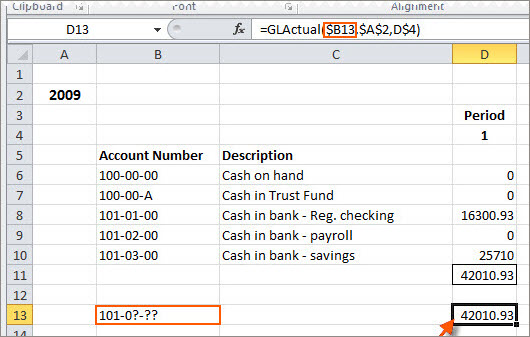Wildcards can be used to define the list of accounts to return in your Sage Intelligence Reporting formulas, without specifically naming each account.
A wildcard character is a keyboard character such as an asterisk (*) or a question mark (?) that is used to represent one or more characters.
The following wildcards are available:
| Wildcard character | Use | Example |
| Question Mark ? | Use the question mark as a substitute for any one of the 36 characters, A through Z and 0 through 9. Multiple question marks (??) can be used to indicate the number of characters to be substituted. Sage Intelligence Reporting replaces each question mark (?) with the entire range of possible values, including letters. For example, in the range from 12?0 TO 12?4, Sage Intelligence Reporting replaces the question mark in 12?0 with the lowest value in the character set, and replaces the question mark in 12?4 with the highest value in the character set. The question mark (?) can be placed in any position of an account segment. For example, if the rule contains only controlling accountsnatural segment valuesthe Main account segment (assuming a four-character controlling accountnaturalMain segment), entering 4??? in a row, all accounts whose controlling accountnaturalMain segment value begins with a 4 will be included. | A??1 to return A001 to AZZ1. |
| Asterisk * | Use the asterisk to substitute any number of characters or numbers. The asterisk can only be placed alone to return all accounts.. | * to return every account |
Wildcards can be used in combination with account
ranges and mathematical
calculations.
Some examples of using wildcards:
| Filter | Description | Result |
| 10? | Filter all accounts beginning with 10 | All accounts starting with 100 up to 109 with any digits thereafter |
| 101-0?-00 | Filter accounts with first segment of 101 and last segment of 00 with second segment of two digits beginning with 0 | 101-00-00 101-01-00 101-02-00 101-03-00 up to 101-09-00 |
| 201-??-10 | Filter accounts with first segment of 201 and last segment of 10 with no filter on second segment of three digits | 201-00-10 201-01-10 201-02-10 201-03-10 up to 201-99-10 |
| 4?00 TO 5?00 | In a
single segment range, filter accounts ranging from 4000 to 5900.
Tip: If you wanted to only include accounts ending with 00, you could create a reporting tree unit with a filter of ??00 to further filter the results. |
Sage Intelligence Reporting will determine the low end of the range which is 4000 and the high end of the range which is 5900 andreturn all accounts between the ends inclusive. 4000 up to and including 5900, which would include for example, account 4655. |
| 4?5-00-00 TO 4?5-03-03 | In
a multi-segment range, filter accounts with first segment ranging
from 405 up to and including 495 and second and third segments
ranging from 00-00 up to and including 03-03.
Tip: If you wanted to only include accounts with the first segment starting with a 4 and ending with a 5, you could create a reporting tree unit with a filter of 4?5-??-?? to further filter the results. |
Sage Intelligence Reporting will determine the low end of the range which is 405-00-00 and the high end of the range which is 495-03-03 and return all accounts between the ends inclusive.405-00-00 up to and including 495-03-03 which would include for example, account 406-01-02. |
